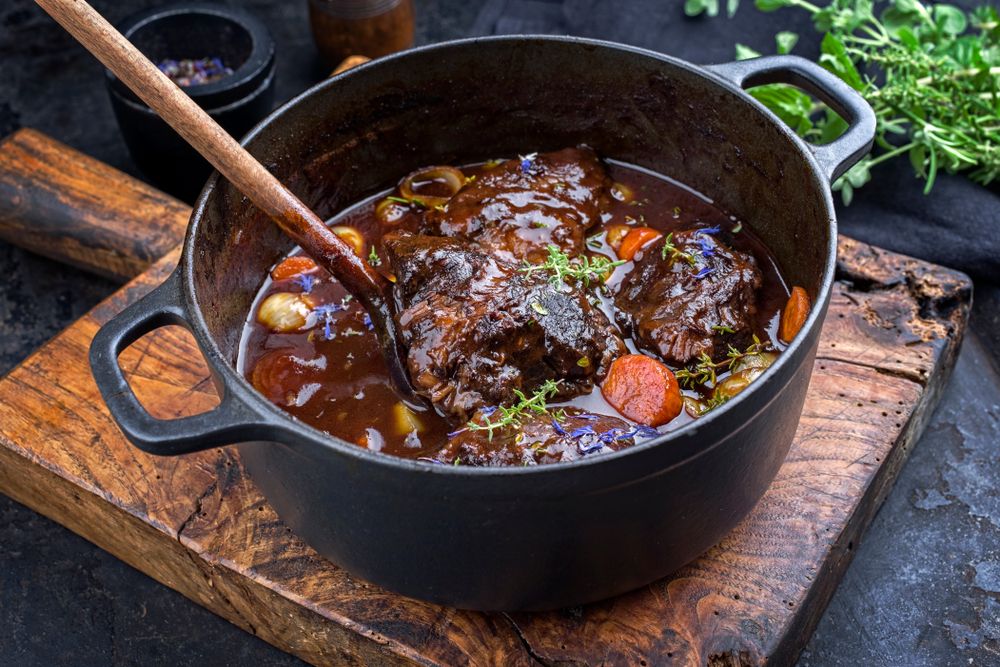A sturdy Dutch oven is a culinary workhorse, particularly beloved for slow-cooked dishes like braising. Its thick walls and tight-fitting lid help lock in moisture, allowing flavors to meld beautifully, whether you’re making beef short ribs, a hearty stew, or a succulent pot roast. But not all Dutch ovens are created equal. With numerous brands, materials, and design features to consider, how do you pick one that suits your cooking style and ensures delicious braises every time?
1. Why a Dutch Oven Is Great for Braising
Braising typically involves searing meat or vegetables in a small amount of fat, then slowly cooking them in liquid (like broth or wine) in a covered vessel. Dutch ovens excel at this because of their heavy construction and secure lids, allowing for consistent, even heat.
Core Advantages
- Even Heat Distribution: Thick walls (often cast iron or enameled cast iron) prevent hot spots and help gently break down tough cuts of meat.
- Moisture Retention: A snug lid keeps steam in, preventing your braising liquid from evaporating too quickly.
- Stovetop-to-Oven Versatility: Dutch ovens can typically move from stovetop for the initial sear straight into the oven for slow-cooking, reducing dishwashing and preserving flavors.
2. Common Materials: Cast Iron vs. Enameled Cast Iron
Traditional Dutch ovens are made from bare cast iron or enameled cast iron. Both are prized for heat retention and even cooking, but each has pros and cons regarding maintenance, ease of cleaning, and aesthetics.
Bare Cast Iron
- Features: Typically black, uncoated cast iron. Requires seasoning for a nonstick surface.
- Pros: Very durable, can handle extremely high temperatures. A well-seasoned surface can impart fantastic browning. Often less expensive than enameled options.
- Cons: Demands regular seasoning to prevent rust, might react with acidic foods if the seasoning is not well-established. Clean-up requires a bit more care (no soap or minimal soapy water is recommended).
Enameled Cast Iron
- Features: Cast iron coated with a porcelain enamel, available in various colors and styles.
- Pros: Non-reactive to acidic foods, simpler cleanup (often dishwasher safe), no seasoning required, and aesthetically pleasing for serving.
- Cons: Usually heavier and more expensive. The enamel can chip if roughly handled. Some brands recommend gentle hand washing to protect the coating.
3. Size and Capacity
Dutch ovens come in a range of sizes—commonly from about 3 quarts up to 8 or 9 quarts. The right capacity ensures you can comfortably fit your braising ingredients plus liquid, without overcrowding.
General Guidelines
- 2–3 Quarts: Good for individuals or cooking small sides, like a pot of beans or a small roast for 1–2 people.
- 4–5 Quarts: A popular middle ground for couples or small families, enough for moderate soups, stews, or braised dishes.
- 6–7 Quarts: Versatile for families of four or more—can handle a whole chicken or larger roast.
- 8+ Quarts: Great for big families, entertaining, or large batches of stew.

4. Shape and Design Features
Small design details—like handle shape, lid knobs, and interior color—can influence how comfortable the pot is to use and how effectively it cooks.
Key Design Elements
- Depth vs. Width: Wide, shallow Dutch ovens expose more surface area for evaporation and browning. Deeper pots handle taller roasts but might be less convenient for browning multiple pieces simultaneously.
- Handles: Look for big loop handles on either side, allowing for an oven mitt’s secure grip. If handles are tiny or oddly shaped, maneuvering a heavy pot becomes risky.
- Lid: A tight-fitting, heavy lid is crucial for trapping moisture. Some lids have spikes or bumps on the underside designed to drip moisture evenly back into the dish.
- Knob Material: Enameled pots often have a knob on the lid. Metal knobs typically tolerate higher oven temperatures than plastic ones—important if you do high-temp braising or bread baking.
5. Heat Tolerance and Usage Scenarios
Braising typically starts on the stovetop (searing meats) and moves into the oven for slow cooking. Ensure the Dutch oven (including lid handles) can handle the temperatures you plan to use—some recipes call for up to 500°F.
Consider
- Stovetop Compatibility: Most cast iron is safe for gas, electric, induction, and sometimes campfires (particularly bare cast iron). Enameled surfaces might have cautionary notes for open flames.
- Oven-Safe Temps: Some enameled lines limit you to 400–450°F for the lid knob. Replacing a plastic knob with a metal one can extend usability.
- Versatility: A Dutch oven that moves seamlessly from stove to oven and even to the table for serving is a major plus.
6. Brand Reputation and Budget
Premium brands often have thicker walls, sturdier handles, and more consistent craftsmanship, but they can be pricey. In the mid-range, you can often find reliable enameled cast iron that performs well for home cooking.
Common Brands
- High-End: Le Creuset, Staub, and similar premium lines known for durability, vibrant enamel finishes, and excellent heat distribution.
- Mid-Range: Lodge (for both bare and enameled cast iron), Cuisinart, Tramontina—these provide good quality at more affordable prices.
- Budget: Some store or no-name brands can be tempting, but check user reviews carefully to confirm enamel resilience, handle security, and consistent thickness.
7. Maintenance and Care
A Dutch oven is a commitment—especially if you choose bare cast iron. Proper care ensures your pot retains its nonstick properties (for bare cast iron) or that the enamel remains chip-free and glossy for years of cooking enjoyment.
Maintenance Basics
- Bare Cast Iron: Seasoning is critical; after each use, clean gently (minimal soap), dry thoroughly, and apply a thin layer of oil.
- Enameled Cast Iron: Usually easier to clean; typically dishwasher-safe, though hand washing is recommended to preserve enamel luster. Avoid metal scouring pads that scratch the surface.
- Avoid Sudden Temperature Changes: Plunging a hot pot into cold water can cause thermal shock, leading to cracks. Let it cool slightly first.
- Long-Lasting: Both forms can last for decades if well-tended, making the initial investment worthwhile.
A quality Dutch oven is an invaluable kitchen companion, especially for braising. By distributing heat evenly and locking in moisture, these heavy-duty pots produce succulent, tender results—be it beef stew, pulled pork, or vegetarian chili. When shopping, think about your primary uses: do you need the heft of a cast-iron bone-chopper, the convenience of an enamel coating, or a certain capacity to feed a large family? Consider your oven temperatures, the pot’s shape and handle design, and how comfortable you are with the required maintenance routine.
Whether you opt for a top-of-the-line enamel brand or a simple yet durable cast iron piece, investing in a Dutch oven can elevate your slow-cooking repertoire. With a little care—like proper cleaning, seasoning if necessary, and mindful storage—your chosen pot can deliver mouthwatering braises for years to come. By focusing on size, material, brand quality, and your personal cooking style, you’ll emerge with the perfect Dutch oven that transforms homemade meals into something truly special.


